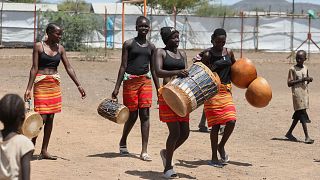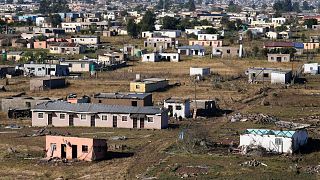Kenya
A last line of defence against the water.
The River Ngare Narok is at safe level now.
But in May this year, it overflowed its banks during the heavy rains that swept across Kenya.
While people were forced to make precarious journeys through the flooded streets, some had taken advantage of a new technology to protect their homes.
These large, black rubber barriers are called slamdams.
They are being used by people who live near water sources.
Frederick Njuguna resides just 50 metres from River Ngare Narok.
But when the floods came, his slamdams stopped the water from reaching his home.
"If I did not have these slamdams, the loss would have been severe. I was considering the value of my property, myself and my children, and I would have suffered a loss of nothing short of 40 to 50 million (Shillings, approx. $310,000 to $390,000). Because if you consider the investments I have made on this land, you can come in and have a look, I would have lost a huge amount of money," he says.
The technology has a second use.
They can be used to store water.
So once the rainy season is over, he can use the slamdams as a water source for his crops.
It's a convenient and simple solution in the dry season.
"When it is time to store the slamdams, instead of discarding the water, he (Fredrick Njuguna) pumps it to water his crops. The crops grow, thrive and provide food. When he exhausts water from one slamdam, we store it and move on to the next slamdam," says Peter Ekale, a slamdam technician.
Fridah Nduuru knows the havoc the rains bring only too well.
While out at church on a wet Sunday, she received alarming news from her neighbours that her home in Buuri, Meru was being flooded.
She hurried home to salvage her belongings.
A runoff from uphill flows through her compound, posing a constant threat to her homestead.
But now she has strategically placed slamdams along the runoff to direct water away from her home.
The barriers were given to her by SNV (Foundation of Netherlands Volunteers) - a Netherlands development organisation the works to help improve food, energy and water systems in Africa and Asia.
"I got this donation from the Netherlands Development Organisation SNV after heavy rains flooded my house and destroyed my property. After I got the slamdams, I am now safe and my home no longer floods," she says.
Slamdams, made from heat-resistant rubber, have a water capacity of 8,000 litres each.
Each slamdam measures five metres in length, 1.5 in width and stands one metres tall.
To ensure effectiveness, slamdams must be placed closely together, forming a tight-knit barrier that prevents any gaps where floodwaters could potentially leak through.
They have a lifespan of up to 40 years.
“A slamdam is a mobile flood barrier. It is made of rubber and it is used for many purposes. Particularly in Kenya, we have used it for flood management and we are also using it now for water harvesting," James Mwangi, Water Resource Specialist at Netherlands Development Organisation (SNV) Kenya says.
SNV has donated 100 slamdams to flood-prone areas in Laikipia County to mitigate the effects of flooding.
"During the normal rains, the water level comes to this level, where I am standing. But in extreme events when we are having floods, the water level will rise beyond this up to about one meter, and when it happens, it tends to spill over towards communities and villages and farms. So the slamdams have been placed to raise the river bank by 1.5 metres," says Mwangi.
According to the government of Kenya, floods caused by heavy rain between March and May this year destroyed crops on more than 168,000 acres (67,987 hectares) of land.
National Disaster Operation Centre (NDOC) figures show that 291 people were killed by floods while 278,380 people were displaced.













00:28
Nairobi hawker shot at close range by police declared brain dead
00:48
Death toll in Kenyan anti-government protests rises to 16, says rights group
01:07
Kenya prepares for first anniversary of Finance Bill protests
01:52
UN's crucial humanitarian aid work faces a clouded future amid cuts in funds
02:00
Refugees in Kenyan camp face hunger after USAID funding freeze
01:00
Pix of the Day: June 19, 2025